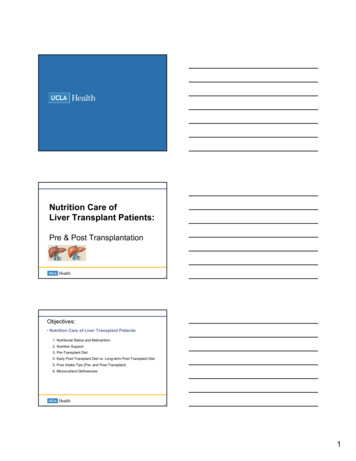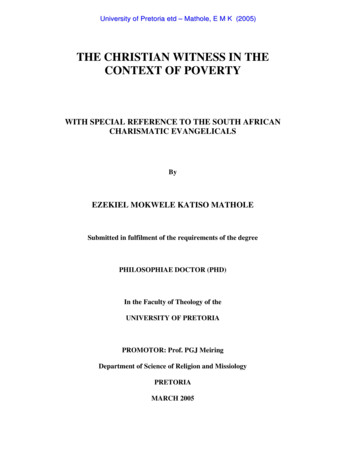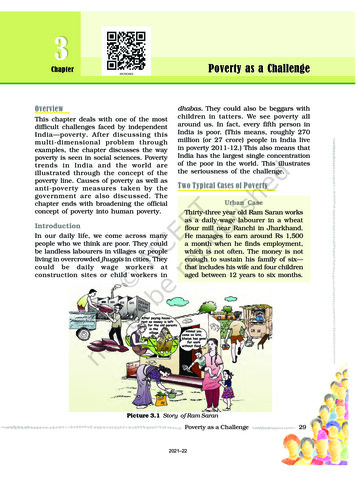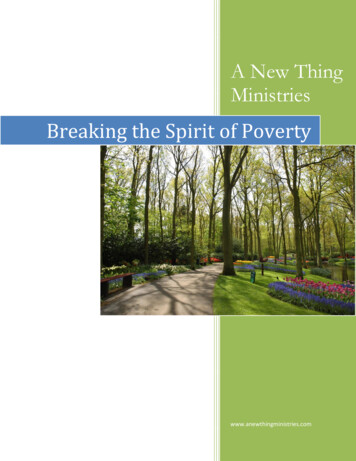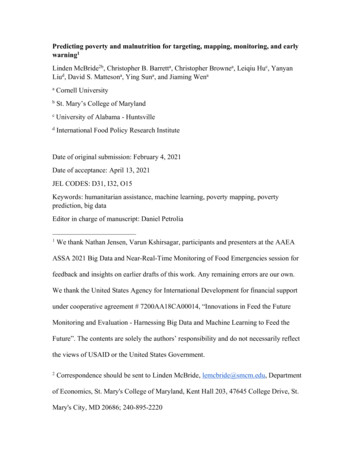
Transcription
Predicting poverty and malnutrition for targeting, mapping, monitoring, and earlywarning1Linden McBride2b, Christopher B. Barretta, Christopher Brownea, Leiqiu Huc, YanyanLiud, David S. Mattesona, Ying Suna, and Jiaming WenaaCornell UniversitybSt. Mary’s College of MarylandcUniversity of Alabama - HuntsvilledInternational Food Policy Research InstituteDate of original submission: February 4, 2021Date of acceptance: April 13, 2021JEL CODES: D31, I32, O15Keywords: humanitarian assistance, machine learning, poverty mapping, povertyprediction, big dataEditor in charge of manuscript: Daniel Petrolia1We thank Nathan Jensen, Varun Kshirsagar, participants and presenters at the AAEAASSA 2021 Big Data and Near-Real-Time Monitoring of Food Emergencies session forfeedback and insights on earlier drafts of this work. Any remaining errors are our own.We thank the United States Agency for International Development for financial supportunder cooperative agreement # 7200AA18CA00014, “Innovations in Feed the FutureMonitoring and Evaluation - Harnessing Big Data and Machine Learning to Feed theFuture”. The contents are solely the authors’ responsibility and do not necessarily reflectthe views of USAID or the United States Government.2Correspondence should be sent to Linden McBride, lemcbride@smcm.edu, Departmentof Economics, St. Mary's College of Maryland, Kent Hall 203, 47645 College Drive, St.Mary's City, MD 20686; 240-895-2220
AbstractIncreasingly plentiful data and powerful predictive algorithms heighten the promise ofdata science for humanitarian and development programming. We advocate for embraceof, and investment in, machine learning methods for poverty and malnutrition targeting,mapping, monitoring, and early warning while also cautioning that distinct objectivesrequire distinct data and methods. In particular, we highlight the differences betweenpoverty and malnutrition targeting and mapping, the differences between structural andstochastic deprivation, and the modeling and data challenges of early warning systemdevelopment. Overall, we urge careful consideration of the purpose and use cases ofmachine learning informed models.IntroductionRecent extreme weather events, food price shocks, the COVID-19 pandemic, andoutbreaks of violent conflict have all vividly demonstrated that food emergencies arisequickly and effect their greatest devastation on already vulnerable and disadvantagedcommunities. Significant information gaps have long impeded effective humanitarianresponse to food emergencies. This was true during the ‘four famines’ declared by theUnited Nations in 2017 and remains true amid the current pandemic response around theworld today. Agencies responding to such crises or working on longer term developmentto reduce vulnerability to food emergencies need tools to help manage the coupledchallenges of relief and development programming.The tools agencies need vary according to the task at hand. Accurate and up-to-datehousehold targeting and deprivation mapping can help ensure scarce resources get
directed to the subpopulations that most need and benefit from them, minimizing wasteand accelerating relief. Rigorous monitoring and evaluation (M&E) systems canaccelerate learning how best to deploy limited resources for maximal impact. Earlywarning systems can help with resource mobilization and accelerate timely delivery ofcontextually appropriate interventions. The appropriate intervention may differ, however,by type of deprivation being targeted, mapped, monitored, or forecasted.The rapid digitization of even low-income regions makes unprecedented volumes of dataavailable in near-real time, potentially enabling rapid and significant advances indevelopment agencies’ toolkits. Call detail records, mobile phone apps, remote sensing,and social media abound with data. We have more available information about humanmovement, behavior, and interactions, and on the natural and cultivated environmentsthan ever before. Simultaneous improvements in data science methods, which we broadlylump under the heading of ‘machine learning’, equip analysts to process ever largervolumes of data faster and extract from those ‘big data’ highly predictive feature sets fora given response variable as well as develop models with highly flexible functionalforms.Machine learning methods are improving the accuracy of household level poverty andmalnutrition targeting tools (Kshirsagar et al. 2017; McBride and Nichols 2018;Knippenberg et al. 2019; Aiken et al. 2020; Blumenstock 2021). Recent advances in bothdata and methods have enabled production of high quality, subnational maps withtolerably accurate estimates of current and probable poverty and malnutrition conditions(Jean et al. 2016; Yeh et al. 2020). Likewise, poverty and malnutrition forecasting for thepurpose of early warning is making incremental gains (Yeh et al. 2020; Browne et al.
2021; Tang et al. 2021). While development and humanitarian programming are enjoyinga machine learning and big data revolution, there exist real risks that these new dataseries and methods underdeliver on the promise of improving targeting, mapping,monitoring and early warning. Careful evaluation and validation work are as important asthe efforts to advance the data and methodological frontiers of these tools.While the appeal of machine learning applications to poverty and malnutrition targeting,mapping, M&E, and forecasting during an era of increasingly big data derives from themethods’ ability to produce flexible, data-driven, predictive models, analysts must stillcarefully consider the purpose and possible use cases of different models. Consider, forexample, the trade-offs between a household level proxy means test (PMT) targeting tool,with household consumption expenditures as the dependent variable, that has as itsfeatures (i.e., explanatory variables) a set of household asset holdings that jointly explainpermanent income versus a tool that simply includes the feature set that exhibits thegreatest predictive power in the available data. The former, asset-based, model mightinclude such assets as materials of housing construction, livestock holdings, and theeducation of heads of household -- all features that well-accepted theory suggests reflectlong-term welfare status -- while the latter model, built on the most predictive feature setavailable, might include any strong correlates of current consumption, such as the amountof meat consumed in the last seven days and whether a household member is currentlyemployed or not. The latter model may better identify the currently poor, but may alsolead to greater errors of inclusion and exclusion if the objective is to target thestructurally poor. Moreover, opportunistic models may prove more vulnerable to
degradation in predictive accuracy over time than might models founded in empiricallyvalidated theory.Trade-offs also exist between highly predictive models built with hundreds of featuresand smaller, simpler models that predict less accurately but are transparent, easy tointerpret, implement, and update. The former may prove more useful for an agency,replete with technical expertise and adequate budget to harvest data continuously, thatseeks a poverty map, but may be less useful for poverty targeting, program evaluation,monitoring and the like for a smaller operational agency if the more onerous datacollection task that supports the model is infeasible to undertake on either an urgent orregular basis. Overall, effectively fitting tools to tasks requires attention to an operationalagency’s objective function (Zhou et al. 2021).As Carter and Barrett (2006) note, most of the work we do in identifying the poor is“almost unavoidably backward looking” due to the nature of data; this observation alsoapplies to the task of identifying the malnourished and food insecure.3 However, thequestion most operational agencies seek to answer is: who will be poor or malnourishedin the future? Of course, no method can reveal the future with certainty; the combination3We are abstracting from important definitional challenges throughout this paper:determining a poverty line, local and global nutrition standards, and food securitythreshold (even measuring food security) are all non-trivial tasks. See Barrett (2010) foran introduction to the challenges of measuring food security, UNHCR (2005) for anintroduction to the challenges of defining nutrition standards, and Ravallion (2020) for anintroduction to the challenges of measuring poverty.
of machine learning and big data does not provide us with a crystal ball. We can,however, leverage big data and machine learning methods to make effective, efficienttargeting tools by paying careful attention to the trade-offs to various approaches tomodeling and data inputs. Valuable progress has been made on all these fronts. Wereview and discuss this progress while also highlighting the differences between targetingand mapping, the differences between identification of the stochastically poor and thestructurally poor, and discussing the modeling challenges of developing early warningsystems as well as data collection efforts to support all these efforts going forward.Targeting versus MappingEmergencies disproportionately impact places that suffer high levels of chronic poverty.Therefore, understanding spatial patterns of deprivation is one of the primary analyticaltasks confronting an operational agency. Both targeting and mapping tools assist withthese endeavors as well as related tasks such as M&E. The basic difference betweentargeting and mapping is that targeting identifies households or individuals whilemapping identifies geographic areas. However, the two can and often are productivelycombined. For example, one might use geographic targeting based on poverty maps as acoarse level tool to identify poor regions or regions with high welfare heterogeneity andthen develop PMTs to target individuals/households within the targeted geographic areas(see Blumenstock 2021 for a great application of such two stage targeting). Below, wemake some distinctions between targeting and mapping, note recent advancements, andidentify research frontiers in both areas.At its most basic level, a targeting tool such as a PMT assigns weights to a set of easilyidentified household characteristics so as to approximate either households’ welfare or
households’ probability of falling below a welfare threshold (Grosh and Baker 1995;Coady et al. 2004; Schriener 2007). In most cases, stock variables, such as householdasset holdings, are on the right hand side of a targeting model and flow variables, such asconsumption, food security status, or a binary indicator variable capturing consumptionor food security status below a threshold, are on the left hand side. Many developmentand social protection programs identify eligible participants based on PMTs. They alsouse such tools for monitoring, evaluation, and impact evaluation purposes, whereappropriate.Recent innovations in poverty and malnutrition targeting have built upon the “scorecard”approach to tool development -- a scorecard includes a short list of observable householdcharacteristics with corresponding estimated weights (Schriener 2007) -- using machinelearning algorithms and techniques for dimension reduction and out-of-sample validation.Building on the basic function of a PMT, McBride and Nichols (2016) demonstrate thetargeting gains of out-of-sample testing for model selection, whether using standardapproaches such as logit and quantile regression or machine learning approaches such asrandom forests. Recognizing that agencies need simple scorecards and often have to buildthem using limited (as opposed to “big”) data, Kshirsagar et al. (2017) demonstrate thathighly predictive models using no more than ten variables can be built on limited datausing cross-validation and parameter regularization for feature selection.Kshirsagar et al. (2017) also highlight the important role of bootstrap aggregation -parameterizing a model by averaging over many subsamples from the data -- withinmodel development to achieve a model that performs consistently well acrosssubpopulations within a country. Baez et al. (2019) emphasize the value and importance
of using child malnutrition indicators, as opposed to consumption or expendituremeasures, as the outcome variable in a targeting model when interested in child wellbeing among agricultural households. In producing a drought-contingent targeting modelusing Demographic and Health Survey (DHS) data combined with NormalizedDifference Vegetation Index (NDVI), Baez et al. (2019) find that simple and easilyinterpreted methods such as logistic regression and classification trees do just as well asblack box methods such as random forest and gradient boosting in the prediction of childlevel stunting, suggesting that the trade-offs between interpretability and strongprediction may be modest. Baez et al. (2019) also make clear the value of augmentingrelatively sparse data, such as DHS household level surveys, with big data such as NDVIsatellite data for targeting purposes.One challenge of targeting tools is that model parameters may shift over time and space,meaning the model needs to be reparameterized to remain accurate when applied to a new(including future) population. This is a challenge because nationally representativehousehold surveys are few and far between. Another challenge is that targeting toolsrequire further data collection for application to a given subpopulation for the purpose oftargeting: to be used for targeting or monitoring purposes, the model weights must beapplied to current household assets and characteristics. Therefore, important innovationsin targeting tool development include those that look to new data sources forparameterization and/or application of the model.Such innovations include Altındağ et al. (2021), Blumenstock (2021), and Aiken et al.(2020). Altındağ et al. (2021) demonstrate that a PMT tool developed to assist theLebanese government in disbursing aid to Syrian refugees could be applied to
administrative data already held by the government. This innovation acceleratesdisbursement and reduces costs by obviating the need for a costly household survey.Blumenstock (2021) use a representative mobile phone based survey, in areas identifiedthrough a poverty mapping exercise, to build and deploy a PMT targeting tool based onmobile phone use during the COVID-19 pandemic. With the noted limitation that thosewho do not own a mobile phone SIM card will not have access to the targeted transfers(and the research team does a great deal to limit the population that will fall into thiscategory), this approach resolves many of the challenges of conventional targeting tooldevelopment and deployment and will only become more effective as mobile phoneownership becomes more ubiquitous. Likewise, Aiken et al. (2020) find that call detailrecords (CDRs) perform as well as a survey based PMT in identifying the ultra poor inthe Balkh province of Afghanistan for the subset of households that own phones. Theyalso find, however, that CDRs are not strong predictors of household wealth in general inthis setting, likely due to sample homogeneity. Use of satellite imagery to capturehousehold level asset holdings, such as housing roof top material, may be another wayforward in streamlining household level targeting.Poverty mapping is a related but distinct task from household- or individual- leveltargeting. In contrast to targeting tools, mapping focuses not on households but ongeographic aggregates showing the spatial distribution of welfare (Ghosh and Rao 1994,Elbers et al. 2003; Coudouel and Bedi 2007). Historically, mapping has been conductedat a relatively coarse scale, such as first or second administrative levels within or acrosscountries. With increased spatial precision from various Earth observation products, it isnow feasible to produce welfare estimates at far more precise – village, or sub-village,
prospectively even plot – scales, which means the lines between geographic mapping andhousehold level targeting are blurring. Further blurring the lines is the fact that thegeographic aggregation of household level data may be used to communicate welfaredistributions even though the disaggregate, household-level, data are readily available.The distinction between mapping and targeting then may come down to whether it is theobjective of the analysis to identify variation in welfare across geographic space, oracross households as identified by their observable characteristics (possibly includingtheir geographic location).Recent advances in poverty mapping and small area estimation include the use of mobilephone records, nightlights data, daytime satellite imagery, and other remote sensing datacombined with various machine learning models (or models more recently grouped intomachine learning, such as elastic nets) for increasingly accurate projections of the spatialdistribution of poverty, food (in)security, welfare, or measures of human development(Noor et al. 2008; Blumenstock et al. 2015; Jean et al. 2016; Steele et al. 2017; Pokhriyaland Jacques 2017; Engstrom et al. 2017; Head et al. 2017; Masaki et al. 2020; Hersh etal. 2020; Yeh et al. 2020; Browne et al. 2021).In particular, Blumenstock et al. (2015) introduce CDRs as a predictor of the distributionof asset wealth in regions of the world for which household level data are otherwisesparse. Jean et al. (2016) demonstrate that convolutional neural nets (CNN) trained topredict nighttime light intensity from daytime satellite imagery can capture 55-75 percentof the variation in asset wealth (as reflected in the widely used and internationallystandardized DHS wealth index) within a given country and 41-56 percent of thevariation in consumption expenditures. While Jean et al. (2016) find success in predicting
asset wealth, they find less success predicting consumption expenditures. This finding isechoed by findings in Barriga Cabanillas et al. (2021) and Tang et al. (2021); overall,stock measures appear easier to predict than flow measures.While the trend in mapping is to combine disparate data sources, it should be noted that,as the data input demands grow, so does the burden and expense of updating themodel/map. A number of papers directly address these and other data challenges. Hershet al. (2020) demonstrate that reasonably accurate poverty maps can be developed usingonly open source data, reducing the cost burden of map development and maintenance fornational statistics offices. Yeh et al. (2020) demonstrate that CNNs trained on onlynightlights or only multispectral daytime imagery do about as well as those trained onboth nightlights and daytime imagery in the prediction of asset poverty across space, asthe inputs capture the same variation. Such observations help reduce the input demandsfor high resolution spatial mapping.Yet et al. (2020) also find that nightlights data performed poorly relative to daytimeimagery in predicting asset wealth over time, in large part because the nightlights data didnot vary sufficiently over time in the sample regions. This finding highlights another keychallenge of mapping with big data: often the data that are most abundant have limitedvariation among the poorest of the poor (Blumenstock 2016, 2020). For example, BarrigaCabanillas et al. (2021) demonstrate the limitation of CDRs in the prediction of foodsecurity outcomes in Haiti; they find that these records don’t capture variation at thelower end of the welfare distribution. Given the limitations of nightlights and CDRs,some recent mapping models focus on use of NDVI, Solar-Induced ChlorophyllFluorescence, and other remotely sensed data that may better correlate with the welfare of
households reliant on local agricultural systems for their livelihoods or for food supplies(Tang et al. 2021; Browne et al. 2021).In addition to poverty mapping, recent advancements have been made in the mapping ofother measures of deprivation. For example, Njuguna and McSharry (2017) combine dataon mobile phone ownership and the number of calls per phone with nightlights andpopulation density data to map the multi-dimensional poverty index for Rwanda.Pokhriyal and Jacques (2017) also map the multi-dimensional poverty index withinSenegal at the commune level by using a combination of data sources including mobilephone records, climate and vegetation data, data on soils and crop production, and otherremotely sensed and geospatial data.Big data and machine learning informed mapping methods have not performed as well inpredicting indicators of malnutrition as they have in predicting asset wealth and poverty.For example, Head et al. (2017) replicate the success of Jean et al. (2016) in predictingasset wealth, explaining approximately 70 percent of the variation in the DHS wealthindex across space using satellite imagery. They also find moderate success predictingelectricity, education, and mobile phone ownership, with 𝑟 ! values from 24-64 percent.However, they find very poor performance in predicting child anthropometric outcomes.A significant challenge in predicting malnutrition outcomes is that they tend to bemeasured with noise and some workhorse measures, such as severe wasting, are,thankfully, less prevalent than poverty (Head et al. 2017; Baez et al. 2019). To addressthis challenge, Zhou et al. (2021) use oversampling combined with random forest andgradient boosting models; they demonstrate that oversampling rare and noisy foodinsecurity outcomes in model development can significantly improve predictive accuracy
in the targeting and forecasting of food insecurity at the cluster level. Noting thatmalnutrition outcomes are strongly correlated with wealth, which Jean et al. (2016), Headet al. (2017), and many others predict with accuracy, Browne et al. (2021) propose jointprediction of malnutrition and wealth measures. Browne et al. (2021) find modestimprovement in predicting malnutrition indicators over time using multivariate randomforests. The objective is to parse signal from noise by harnessing multivariate analysis;this line of research merits further exploration.Mapping and targeting differ fundamentally in terms of objectives and (geographic) scaleof output though they can be, and often are, fruitfully used together. Machine learningand big data have enabled exciting advancements in the efficiency and accuracy of bothtargeting and mapping. However, we join Head et al. (2017) in urging caution whengeneralizing the results of successful approaches such as Jean et al. (2016) to othercontexts and outcomes. Sufficient variation in the input variables and sufficientcorrelation with the outcomes of interest are minimum requirements for a targeting ormapping model to accurately identify the poor or malnourished. In comparison tomapping, targeting has not enjoyed as much innovation in recent years. This may be dueto the fact that geography is a strong determinant of poverty and malnutrition andtherefore, household level targeting is not as great a priority as is geographic targeting foroperational agencies. It is also in part due to the fact that big data are not yet abundant atthe household level. Targeting advances by Blumenstock and co-authors based on CDRsprove the exception to this; however, as noted above, in many places these data still offerlimited information about the population of interest, the poorest of the poor (Blumenstock2020; Barriga Cabanillas et al. 2021).
Structural versus stochastic poverty and food insecurityThe poor include those who are always poor as well as those who move in and out ofpoverty, with some evidence that the latter group make up a substantial proportion of thepoor at any given point in time. For example, Baulch and Hoddinott (2000) find that 2065 percent of households across 13 panel studies are classified as “sometimes poor,” acategory more numerous than the “always poor” classification. They also findconsiderable heterogeneity in the duration of poverty within the transitory poor.4Likewise, Knippenberg et al. (2020) find that most food insecure households in Malawitransition in and out of food insecurity, with significant heterogeneity in food insecurityspell length. Distinguishing between structural and stochastic deprivation5 is importantfor well-targeted interventions and requires the targeting, mapping, monitoring, or early4An important caveat to these observations is that transience in welfare status is typicallyoverestimated in available data due to measurement error and short panel intervals(Naschold and Barrett 2011). In addition, while the transitory poor and food insecuremake up a majority of the poor and food insecure on headcount measures, they are notnecessarily the majority in more distributionally sensitive metrics, as the depth of povertyand food insecurity is typically greatest among the most chronically deprived.5One might consider seasonal food insecurity along these same lines: some seasonal foodinsecurity is structural, some stochastic (V. Kshirsagar, personal corresp. 2021). Whereparsing structural seasonal food insecurity from stochastic seasonal food security isimportant for a well-targeted intervention, the concerns we identify here apply.
warning model to account for the structural determinants of deprivation (Carter andBarrett 2006).How can one account for the structural determinants of deprivation in such a model?Because permanent (i.e., expected) income and thus consumption expenditures areendogenous to the stock of productive assets one controls, identifying the structuraldeterminants of poverty entails considering the dynamics of asset accumulation, where“asset is understood to broadly include conventional, privately held productive andfinancial wealth, as well as social, geographic and market access positions that confereconomic advantage” (Carter and Barrett 2006). Much empirical work supports thisasset-based theory of welfare dynamics (Barrett et al. 2006; Carter and Lybbert 2012;Barrett et al. 2019; Balboni et al. 2020).An asset-based understanding of welfare dynamics can assist one in identifying thestructural poor in a targeting or mapping setting. One useful, data-driven, distinction isoffered by Carter and May (1999): households that are currently poor (according to theircurrent level of consumption or expenditures) but for whom a conditional expectationfunction of consumption/expenditures given current asset holdings predicts a non-poorstandard of living are considered stochastically poor; those that are currently poor and forwhom a conditional expectation function of consumption/expenditures given currentasset holdings predicts a poor standard of living are considered structurally poor. Thisdistinction reinforces the value of including asset holdings as features when developingtargeting models where the primary group of interest is the structural poor. Assetholdings have the additional advantage that they are often verifiable whereas otherpredictors of welfare, such as how much meat was consumed in the past week, may be
more challenging to verify. However, there is tension between the asset-based theory ofwelfare dynamics, wherein asset holdings are important in determining long termdeprivation, and standard big data/machine learning approaches to model development,which are often based on the most predictive feature set for a given response variable.Big data rarely include household level asset holdings, and models with the highest out ofsample r2 may not do a great job identifying the structurally poor and food insecure, asthese are generally a subset of the overall currently poor.Where the distinction between stochastic and structural poverty or food insecurity isneeded for well-targeted interventions, more household level survey data may be needed.Where such data are not available, mapping for the purpose of geographic targeting maybest capture the persistent spatial distribution of poverty and malnutrition. Geographytypically reflects the confluence of multiple market and state failures and may directlyinfluence structural poverty and malnutrition. Moreover, geographic targeting isrelatively quick and cost-effective, especially as compared to household- or individuallevel targeting. Indeed, there is growing evidence that much persistent poverty is placebased and that escape from such poverty often involves migration (Jalan and Ravallion2002; DeWeerdt 2010; Beegle et al. 2011; Ravallion and Wodon 1999; Pritchett and Hani2020). Yeh et al. (2020) suggest, and take a few steps in the direction of, using povertymapping as an avenue to learn more about the determinants of geographically distributedstructural poverty; this is an important direction for further research.Static versus dynamic modelsCan advances in machine learning methods and data availability improve early warningsystems, such as would allow us to predict the mass movement into (or deepening of)
poverty or malnutrition in an upcoming period? For the identification of individuals,households, and/or regions that will experience poverty in the next period and theanticipation of the consequences of shocks on vulnerable populations, dynamic ratherthan static models may be necessary. By dynamic models we mean models that take asinputs and produce as outputs changes over time. With few exceptions, poverty mappingand poverty targeting efforts tend to produce static models, defined as fixed point orinterval values (for stocks and flows, respectively) rather than as intertemporal change inthose values. This is in large part due to data limitations. Although similar in nature, thetasks—early warning vs identifying the presently poor or malnourished—requiredifferent tools and inputs. Most critically, dynamic models require panel data, i.e.,repeated observations over
data and methods have enabled production of high quality, subnational maps with tolerably accurate estimates of current and probable poverty and malnutrition conditions (Jean et al. 2016; Yeh et al. 2020). Likewise, poverty and malnutrition forecasting for the purpose of early warning is making incremental gains (Yeh et al. 2020; Browne et al.

